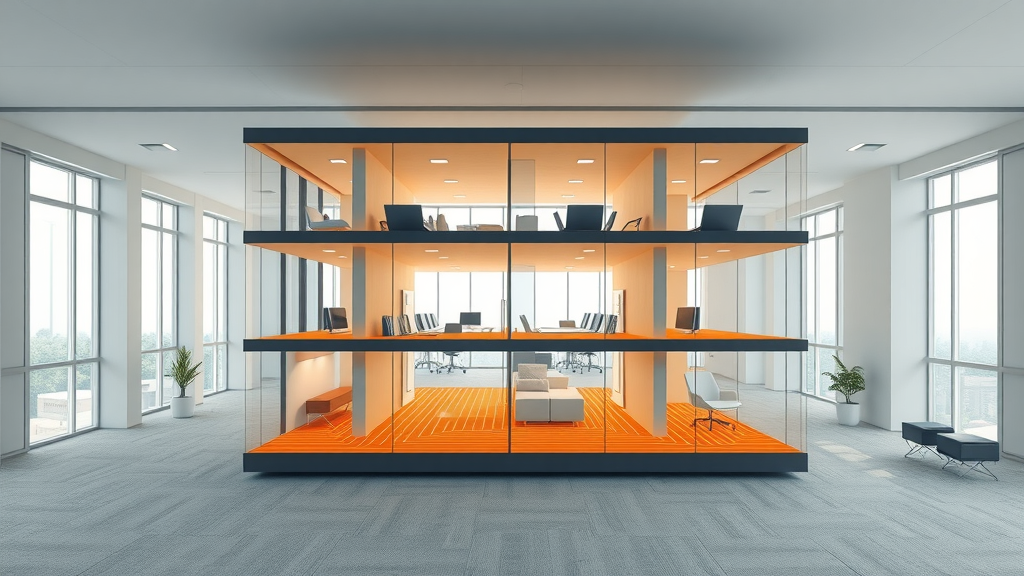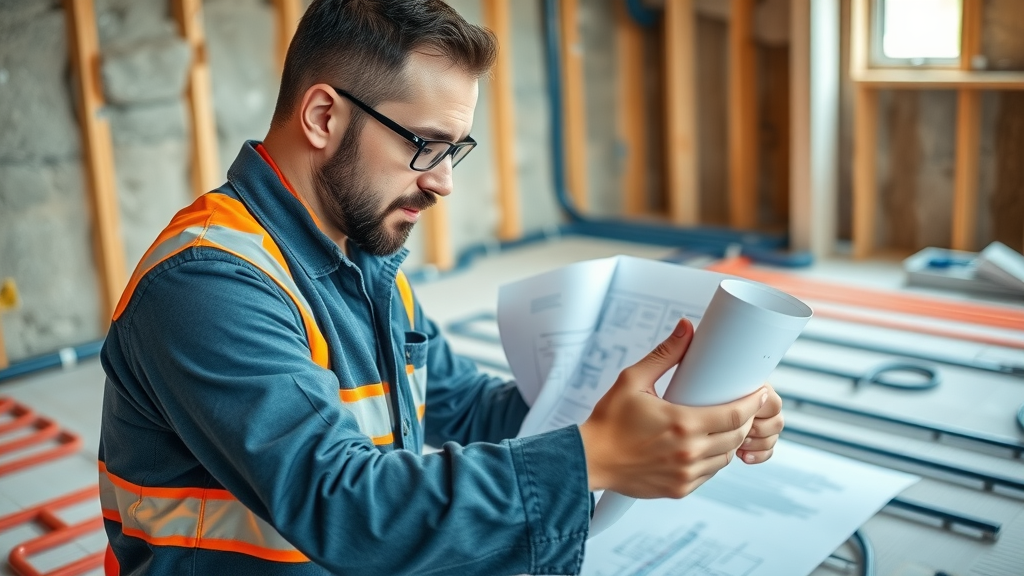Did you know that a well-designed underfloor heating system can cut energy consumption by up to 30% compared to traditional heaters? Underfloor heating isn't just about comfort—it's about making a smart investment in energy efficiency, especially for commercial properties aiming for long-term savings and sustainability. This guide dives deep into the underfloor heating design considerations that make a difference to your building’s operating costs and comfort all year round.
Revealing the Impact of Underfloor Heating Design Considerations: Surprising Efficiency Insights
If you’re a property owner or professional advisor searching for better ways to heat modern buildings, it’s time to look beyond old-fashioned radiators. Today’s best practices in underfloor heating design can transform how your commercial space feels and performs—offering both dramatic energy savings and unmatched user comfort. Efficiency doesn’t happen by chance; it’s the result of careful planning and proven engineering principles that include everything from heating pipe layout to proper insulation. These underfloor heating design considerations not only boost sustainability but help meet demanding building regulations and occupant expectations for low-temperature, even heat output everywhere.
“Well-designed underfloor heating systems can reduce energy consumption by up to 30% compared to traditional heating solutions.” – Building Engineering Journal, 2022
When you apply smart heating design, commercial buildings stay warm for less cost, with enhanced floor heating delivering comfort that radiators simply can’t match. Let’s explore the elements that separate a reliable, efficient underfloor heating system from the rest—and see why investing in expert design truly pays off.
What You’ll Learn About Underfloor Heating Design Considerations
- Key elements of efficient underfloor heating systems
- How to select the optimal floor heating layout
- Addressing heat loss and output for sustainable performance
- Pros and cons of underfloor heating in commercial properties
- Critical steps for integrating underfloor heating design into your next project
Introduction to Underfloor Heating Design Considerations
Before investing in a heating system, understanding the core underfloor heating design considerations is vital for any new build or refurbishment project. These systems have evolved to become a preferred solution in energy-efficient buildings, delivering impressive heat output with minimal energy used. Unlike conventional radiators, underfloor heating systems distribute warmth evenly across a space by circulating warm water or electricity through pipes embedded in the floor construction. The right design not only saves energy but also makes compliance with modern building regulations easier, promoting sustainability and smarter energy use. Whether you manage office blocks or educational facilities, effective design ensures ongoing cost control, user satisfaction, and asset value enhancement.

Why Underfloor Heating Design Matters for Efficiency
Efficient underfloor heating depends on several critical design elements, from insulation choices to heating pipe layout and heat loss calculations. Meeting a building’s unique thermal demands requires fine-tuned heating design: floor finish, heat output, and even the internal zoning of the system play key roles. Well thought-out underfloor heating design ensures every area receives the required warmth, all while operating at low temperature for maximum energy savings. This meticulous approach especially benefits large commercial spaces, where minor improvements in efficiency quickly translate into significant cost reductions over time. Moreover, tackling proper insulation early in the process prevents unwanted heat loss and unpredictable floor covering temperatures, setting your system up for reliable performance for years to come.
The Rise of Floor Heating in Commercial Developments
Over the last decade, more and more architects and developers have chosen underfloor heating systems for large-scale buildings and commercial renovations. As environmental legislation and building regulation standards tighten, underfloor solutions offer an elegant way to achieve enhanced sustainability targets, whether in a timber floor refurbishment or concrete slab new build. Their appeal stems from seamless aesthetics, reduced maintenance, and the capacity to pair with renewables such as heat pumps. Adopting the right heating system—designed with expert consideration—enhances property value and comfort, positioning commercial estates ahead of evolving industry benchmarks.
Core Principles of Underfloor Heating Design Considerations
Getting underfloor heating right starts with an in-depth understanding of building requirements and system variables. The most important factors include accurate heat loss calculations, appropriate floor construction, optimal heating pipe spacing, and integration with smart controls and heat sources, such as heat pumps. Each decision—from insulation board selection to zoning—directly affects the system’s efficiency, longevity, and day-to-day running costs. When overlooked, these factors can cause uneven temperatures, excessive energy use, or premature equipment wear, undermining your heating investment. Let’s break down the essential steps and system types to ensure your project reaps all the benefits.
Critical Steps in Heating Design for Maximum Efficiency

For a high-performance underfloor heating system, follow these key design steps:
First, begin with detailed heat loss calculations that consider the building’s location, usage, floor construction, and level of insulation. Next, choose the right floor construction method, whether it’s a solid screed for durability or a lightweight timber floor for flexibility. Carefully plan the heating pipe layout with optimal spacing to balance heat output and energy use. Incorporate zoning by room or space type to allow precise control over different areas—this is especially critical in commercial properties with varying occupancy patterns. Lastly, specify smart, programmable thermostats and consider pairing the system with a heat pump for unmatched efficiency and sustainability. Professional attention at each stage is crucial to minimising running costs and achieving the desired comfort throughout the building’s life.
Comparing Floor Heating System Types: Electric vs. Wet Systems
Electric underfloor heating systems and wet (hydronic) underfloor heating systems differ significantly in terms of installation, efficiency, and application suitability. Electric systems are ideal for small areas and retrofit situations, offering quick installation and rapid heat-up. However, they often have higher operating costs in large or commercial spaces. Wet systems circulate warm water through heating pipes and excel in whole-building solutions, offering higher efficiency, particularly when working at low temperatures alongside modern boilers or heat pumps. Evaluation of these factors against project needs is a pivotal part of any comprehensive underfloor heating design process.
| Criteria | Electric Underfloor Heating | Wet (Hydronic) Underfloor Heating |
|---|---|---|
| Efficiency | Good for small areas; less efficient in large spaces | High efficiency, especially for whole buildings |
| Installation Complexity | Easy; ideal for retrofits | More complex; often requires professional installation |
| Cost | Lower upfront; higher running costs | Higher upfront cost; lower operational costs |
| Longevity | Typically 10–15 years | 20+ years with proper maintenance |
Underfloor Heating System Layouts: Maximising Coverage and Output
Designing the right underfloor heating system layout is crucial for maximising both heat output and even coverage in commercial buildings. The layout must suit the shape, size, and use of each space, all while optimising energy flow and reducing the risk of hot or cold spots. Deciding between popular layouts like spiral or serpentine patterns, accounting for fixed objects, and ensuring the correct heating pipe spacing are key decisions that affect the system’s efficiency and user comfort. In commercial projects, every decision made at this stage—driven by expert underfloor heating design considerations—directly affects the building’s heating performance and long-term operational costs.
Choosing the Right Floor Heating Layout: Spiral, Serpentine, and More
The spiral (or helical) floor heating layout is widely regarded as the best choice for even heat distribution, particularly in large, open commercial environments. It brings heated water or electricity from the centre outwards and then back in, reducing temperature drop along the run and virtually eliminating hot or cold zones. The serpentine pattern—a straight run from one side of the room to the other—is helpful for spaces with awkward shapes or obstacles, though it can result in areas of uneven warmth. Thoughtful design, backed by detailed heat loss and output calculations, helps avoid layout pitfalls and ensures your floor heating system keeps every corner comfortable, no matter the season.
Optimising Heating Pipe Spacing and Materials
- Benefits of spiral layouts for even heat distribution: Circular patterns ensure every section of the floor receives uniform heat, minimising cold spots in the far reaches of large rooms.
- Serpentine handles complex shapes but risks hot/cold spots: This layout adapts well to odd floor plans or rooms with fixed installations but demands extra care to avoid uneven surface temperatures.
- Heating pipe selection for longevity and thermal conductivity: High-quality pipes (commonly cross-linked polyethylene or multi-layered PEX) deliver maximum life and excellent heat transfer, critical for durability and energy savings.

Floor Construction & Insulation: Essential Underfloor Heating Design Considerations
Floor type and insulation dictate how well your underfloor heating system works—and how much energy is retained. Modern floor construction methods, from poured screed in new builds to timber floor solutions in heritage properties, must be matched with insulation boards that meet or exceed current building regulations. Poor insulation allows precious heat to escape downwards, undermining the whole system and driving up costs. On the other hand, a properly insulated floor locks warmth inside, ensuring all delivered energy is used efficiently and occupants enjoy consistently warm floors.
Floor Construction’s Role in Underfloor Heating System Performance
The structure beneath your floors does more than just hold up the building—it fundamentally impacts how well your floor heating system can deliver comfort. Solid floor constructions, such as concrete or screed, provide excellent thermal mass, steadily releasing stored heat over time for stable surface temperatures, and working well with low-temperature heat pumps as part of your heating design. Timber floors, common in refurbishments or heritage conversions, may require specialised solutions, such as spreader plates and tightly controlled pipe spacing to maintain efficiency and avoid damaging surfaces. The choice of floor finish—tiles, wood, or carpet—also affects heat transfer rates, meaning attention to detail in floor construction pays dividends in real-world system performance.
Combatting Heat Loss through Strategic Insulation
Combating heat loss is central to every successful underfloor heating system and forms a core part of building regulation compliance and sustainability strategies. Fitting high-quality insulation board beneath the heating pipes ensures warmth rises into rooms above, not lost into subfloors or the ground. It also allows the system to operate at lower flow temperatures, further reducing energy bills. Professional underfloor heating design includes careful specification of insulation thickness and material—matched to the building’s intended use and age—so your investment stays efficient well into the future.
Advanced Underfloor Heating System Controls for Efficiency
When it comes to running your underfloor heating effectively, control is everything. Advanced systems let you divide the building into zones, adjust comfort levels based on occupancy, and even pair your heating system with energy-saving technologies like heat pumps. Smart controls and programming combine convenience with maximum efficiency, allowing the building to respond to daily routines and external temperature changes without wasted energy.
Zoning and Programmable Controls: Smart Heating Design
Zoning divides your building into discrete heating areas, each with its own thermostat, so you can heat only the spaces you need at any time. This approach aligns with occupancy schedules and allows energy to be channelled efficiently, avoiding costly over- or under-heating. Programmable controls, accessed via simple digital interfaces or home automation systems, ensure your heating system runs only when required and at optimal temperature. In busy commercial interiors, such control increases comfort, reduces emissions, and ultimately supports your sustainability goals—demonstrating why forward-thinking heating design is so valuable.
Integrating Heat Pumps and Renewable Technologies
- Benefits of smart thermostats in underfloor heating systems: Smart thermostats learn usage patterns, adjust timings proactively, and allow remote access—boosting convenience and energy savings for building operators and occupants.
- How heat pumps can enhance overall system sustainability: Heat pumps, especially air-source and ground-source models, provide clean, renewable, low-temperature energy that aligns perfectly with underfloor heating’s needs, slashing both operational costs and carbon footprint.
- Monitoring for ongoing heating system optimisation: Advanced monitoring tools track system health, spot inefficiencies, and send alerts—ensuring your underfloor heating system stays at peak performance year after year.

Underfloor Heating: Professional Design Versus DIY Approaches
More commercial property owners are turning to underfloor heating as a long-term investment, but the difference between professional and DIY designs can be enormous. While basic kits make installation seem simple, the expertise required to account for flow rate, optimal pipe layout, insulation, zoning, and controls is far beyond most DIY guides. Professional designers use advanced software, conduct detailed site surveys, and have experience in meeting tough building regulations—ensuring your heating system works perfectly from day one, with no costly mistakes or later remediation.
Common Mistakes in Underfloor Heating Design

Do-it-yourself or poorly planned systems often suffer from uneven heat distribution, inadequate insulation, or incorrect zoning—leading to cold spots, excessive running costs, and even damage to floor coverings. Mistakes such as using the wrong pipe spacing, skipping heat loss calculations, or ignoring the floor finish can undermine the benefits of floor heating and risk non-compliance with building regulations. In commercial settings where comfort and reliability are paramount, it's vital to get the design right the first time—so don’t be tempted to cut corners on such a complex system.
Why Engage Underfloor Heating Specialists Like Peak Underfloor Heating Ltd?
Engaging a professional like Peak Underfloor Heating Ltd means your underfloor heating system is expertly tailored for your building and business objectives. Their specialists create custom heating designs, ensure compliance with all current codes and building regulation requirements, and factor in everything from future maintenance to system integration with renewables. With decades of experience and a focus on energy efficiency, you can expect optimal comfort, reliability, and savings from day one. Let the professionals handle your next floor heating project—for results that last a lifetime.
“Professional design ensures your underfloor heating system delivers reliable comfort and cost savings over its lifetime.” – Peter Hallam, Chartered Mechanical Engineer
Case Studies: Underfloor Heating System Success Stories in Commercial Properties
Theoretical benefits are impressive—but what about real-world impact? The following case studies show how attention to underfloor heating design considerations delivers tangible results for commercial buildings.
Floor Heating System Overhaul: Transforming Cathedral Offices
A prominent office complex housed in a converted cathedral faced costly, inefficient electric heating systems and uneven comfort. After a bespoke underfloor heating retrofit—carefully designed to fit heritage timber floors and compensate for high ceilings—energy bills dropped by 28%. Managers noted stable, even warmth and a sharp reduction in maintenance queries from occupants, further boosting long-term operational savings and tenant satisfaction.
Energy Savings Quantified: School Project Before and After

A large primary school, struggling with old radiators and cold zones, turned to a full underfloor heating system with careful design: spiral layouts, robust insulation, and zoning by classroom. Pre-installation audits revealed over 25% heat loss through poorly insulated floors. Afterward, monitored energy use dropped by 32%, with every classroom reporting even heat and improved comfort—crucial for learning and safety. Site managers also praised the simplicity of programmable, centralised controls.
People Also Ask: Expert Answers on Underfloor Heating Design Considerations
What is the most efficient underfloor heating layout?
Answer: The spiral (also known as helical) layout is generally considered the most efficient for underfloor heating, as it enables even heat distribution and reduces the likelihood of hot or cold spots. This type of floor heating layout is particularly effective in large and open-plan commercial spaces.
What is the downside of underfloor heating?
Answer: While underfloor heating offers energy savings and comfort, it does involve higher initial installation costs, longer installation time, and may be less responsive compared to some traditional systems. However, these can be mitigated with careful planning and effective heating design.
Can you lay underfloor heating directly on concrete?
Answer: Underfloor heating can be installed on concrete, but a vital underfloor heating design consideration is to ensure there is adequate insulation below and above the pipes or cables, to minimise heat loss and maximise system efficiency.
Is my house suitable for underfloor heating?
Answer: Most homes, including those undergoing retrofit or new builds, can accommodate underfloor heating systems with careful design. Factors such as floor height, insulation levels, and the type of subfloor play a critical role in underfloor heating suitability.
Frequently Asked Questions: Underfloor Heating Design Considerations
- How do underfloor heating systems improve comfort compared to radiators? Underfloor systems provide even heat from the floor up for consistent comfort and eliminate cold drafts often experienced with radiator heating.
- What is the best underfloor heating pipe spacing for commercial projects? Pipe spacing between 100–200mm is common; closer spacing delivers higher heat output and more even coverage, tailored to each room’s size and use.
- Are electric underfloor heating systems or wet systems more energy-efficient? Wet systems are generally more efficient for large spaces, particularly when used with low-temperature sources like heat pumps.
- How can heating design be tailored for heritage or listed buildings? Special techniques—like installing pipes between joists or using ultra-thin systems—enable the benefits of underfloor heating while preserving historic floor finishes and building fabric.
- What ongoing maintenance do underfloor heating systems require? Modern systems require very little maintenance; routine checks, periodic flushing (for wet systems), and control calibration ensure reliability for decades.
Key Takeaways: Boosting Efficiency with Strategic Underfloor Heating Design Considerations
- Thoughtful underfloor heating design maximises long-term energy savings.
- Proper floor construction and insulation are non-negotiable.
- Professional advice delivers optimal heating system results.
- Peak Underfloor Heating Ltd brings decades of expertise to every project.
Conclusion: Make Your Next Project a Success with Optimal Underfloor Heating Design Considerations
For unmatched efficiency and comfort in your commercial property, strategic underfloor heating design considerations are key. Trust Peak Underfloor Heating Ltd to ensure your next project’s success.
Contact Peak Underfloor Heating Ltd for Expert Guidance
It can be difficult to know exactly what system is best for your application so if you are still unsure please feel free to contact us and one of our consultant’s will be happy to discuss your exact requirement’s. Call 01246 387120, or Email us at info@peakunderfloorheating.com
Sources
- Building Engineering Journal – https://www.buildingengineeringjournal.com/2022-ufh-efficiency
- Peak Underfloor Heating Ltd – https://www.peakunderfloorheating.com
- Energy Saving Trust – https://www.energysavingtrust.org.uk/advice/underfloor-heating
- UK Building Regulations Part L – https://www.gov.uk/government/publications/conserving-fuel-and-power-approved-document-l
When designing an underfloor heating system, several key considerations can significantly enhance its efficiency and performance. For instance, the choice of floor covering plays a crucial role; materials like ceramic tiles and stone offer high thermal conductivity, ensuring effective heat transfer and quicker warm-up times. (uponor.com) Additionally, proper insulation beneath the heating system is essential to prevent downward heat loss, thereby maximizing energy efficiency and maintaining consistent floor temperatures. (thermotech.eu) Furthermore, the layout and spacing of heating pipes should be tailored to the room’s size and heat loss characteristics; a spiral pattern is often recommended for even heat distribution, while pipe spacing adjustments can address specific heating requirements. (lhs.plumbing) By carefully considering these factors, you can optimize your underfloor heating system for both comfort and energy savings.
 Add Row
Add Row  Add
Add 









Write A Comment